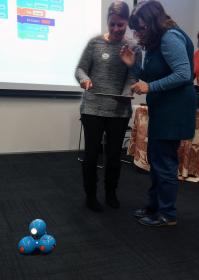Coding
What is coding?
Coding helps students develop systematic reasoning, problem-solving, and communication skills
Coding, or computer programming, is giving a computer step-by-step commands to tell it what to do. This can include making websites, games and apps. Common coding languages include HTML and JavaScript.
Young learners and beginners can begin coding in the classroom using web based programmes – such as Scratch .
- No knowledge of actual coding is required
- Users interlock colour-coded bricks to create interactive games and animations.
Why teach coding?
Students who have mastered coding can construct, hypothesise, explore, experiment, evaluate, and draw conclusions.
Coding is an important and necessary future-focused literacy. It is included as part of the school curricula in many countries who recognise this.
Coding helps to create our digital world and as our world becomes more digital, coding is becoming more of an in-demand and employable skill.
In his 2012 Ted Talk Lets teach kids to code Mitch Resnick outlines the benefits of teaching kids to code, so they can do more than just “read” new technologies – but also create them.
(16.48)
Five reasons to teach coding
- Coding is a tool to improve educational equity.
- Coding offers inclusion.
- Coding can improve neuroplasticity.
- Coding improves Science, Technology, Engineering and Mathematics (STEM) proficiencies.
- Coding is an important and necessary future-focused literacy.
Huerta, Edutopia
Callum and his teacher, Fraser Malins, explain how Scratch supports student learning with creativity, logical thinking, and problem solving at Halswell School.
References
Balanskat, A. & Englehart, K., (2015). Computing our future. Computer programming and coding. Priorities, school curricula and intitiatives across Europe . European Schoolnet.
Start small and allow students to drive the learning
1. Get connected and communicate
Talk to your learners, and ask around your community for people with an interest or knowledge in coding for information and support.
- Code Club Aotearoa runs school coding clubs around the country with the support of volunteers in the community. Not all of the volunteers are teachers.
Ask for help
Talk to colleagues within your school, or as a part of a wider network such as the Teaching with Scratch or Learning With & About Digital Technologies (NZ Teachers) Facebook groups.
2. Learn a little code
To get started, explore resources and self-directed tutorials for both teachers and students.
- TeacherTube offers a range of resources and video clips to support teachers learning to code
- Hour of Code tutorials allows users to learn the basics of computer science with drag and drop programming.
- Codecademy is a web-based environment to start teaching students about about programming and the basic lessons are free.
- CSFirst offers a free computer science curriculum that makes coding easy to teach and fun to learn
You can start students coding without the need for digital devices!
CS Unplugged , a project by the CS Education Research Group at the University of Canterbury, New Zealand, offers a free collection of fun, free learning activities that encourage computational thinking.
3. Make learning authentic
Allow students to explore problems and design different solutions. Coding By Design begins with solving real problems for real people.
“Classrooms that celebrate the process of design and making, which includes overcoming challenges, produce students who start to believe they can solve any problem. Students learn to trust themselves as competent problem solvers who don’t need to be told what to do next. This stance can be a crucial change for children who are used to getting explicit directions every minute of every day.”
– Martinez & Stager (2014)
The Portal Unity Project from CORE Ministry Video on Vimeo.
Year 13 student, Daniel Cowpertwait describes his Portal Unity Project – a modification coded for the online game, Portal. He developed this along with three other students as part of the Impact Project at Albany Senior High School. The authentic context provided many opportunities for learning including specialised technical skill development, a deep understanding of copyright, and working successfully as part of a team. He has been supported in his learning by an expert via the Internet and a mentor. Daniel describes how the cross curricular nature of the project has opened his eyes to the way different disciplines can be combined into a career.
4. Play and have fun with coding
Engage students' curiosity and provide opportunities to explore, play and ‘tinker’ with code, so they are not just learning to code but coding to learn.
Games are one of the best ways to foster a love for coding in kids. There are a vast array of online resources that incorporate learning how to code into gaming. These involve challenges and rewards that scaffold learning and teach fundamental skills.
Encourage girls to code
Women are under-represented in roles that involve creating technology.
- Made with code is a Google project started to inspire girls to contribute their voices to the field of technology.
- Girls who code works to educate, inspire, and equip high school girls with the skills and resources to pursue opportunities in computing fields.
More information »
5. Try one hour of code
You can start with just one hour of coding!
The Hour of Code website offers a one-hour introduction to computer science, designed to demystify code and show that anybody can learn the basics. A global, week long Hour of Code event takes place once a year. But, teachers can host an Hour of Code event all year round.
More information »
References
Heggart, K., (2014). Coded for Success: The Benefits of Learning to Program. Edutopia
Martinez, S & Stager, G., (2014). The maker movement: A learning revolution . ISTE
Coding for adults and teachers
Teaching kids programming
Ministry of Education
One Month: intro to coding
A 90-day program to help you learn the basics of coding.
Code.org
A non-profit organisation dedicated to expanding access to computer science.
Codecademy
Course specific that teaches web developer skills, languages, and more.
Future Learn
Learn how to code or build your skills in programming online to gain a better understanding of how websites and apps are designed and developed.
Programming for Kids - How to Make Coding Fun
A free course for parents, and teachers in schools who want to encourage programming skills in a fun way.
KhanAcademy – Teaching computer programming
Free resource for learning how to teach programming, includes lesson plans and teaching materials.
Coding for students
Self-directed activities and tutorials for students to follow as they learn to code.
Gamefroot
A New Zealand-based platform that uses game development to make coding fun and reflects real life as students publish the games they create.
Code Avengers
Students build their own apps, games and websites as they learn.
Codecademy
Course specific that teaches web developer skills, languages, and more.
Coding in Minecraft
Use blocks of code to take Steve or Alex on an adventure through this Minecraft world.
Khan Academy Programming Tutorials
Practice exercises, and instructional videos on a range of topics for free.
Shake up learning
Lessons, games, and interactives designed to teach coding skills.
Scratch Number Line iPad Monthly
A YouTube clip in which Paul Hamilton explores numbers using scratch Jr App for iPad and coding.
Tynker.com
A creative computing platform for kids.
6 resources to engage students in coding with Scratch
Resources and links for getting started with Scratch in the classroom are in this easy-to-read ISTE blog post (April 2019)
Swift playgrounds
Learn code on your iPad.
Code Monster
A simple introduction to JavaScript. Two adjacent boxes display – one shows the code, the other shows what the code does. The Code Monster offers helpful prompts and a short description of what each command does.
Stencyl is a code-free game development tool that helps kids program and publish. It is a cross-platform 2D game engine with tools that run on Windows, Mac and Linux. It is free to use for publishing to Flash with a watermark. There is a cost for the pro version, which allows publishing to additional platforms.
Coding for younger learners
Robot Turtles
A board game that teaches the fundamentals of programming (3+).
Hopscotch
An iPad app with drag-and-drop blocks of code to create a program.
Code Monkey Island
An adventure board game that teaches kids how to use and master the fundamentals of computer science.
Wonder Workshop
Robot duo Dash and Dot guide kids through the world of coding and robotics.
Kodable
Curriculum-related resources and activities that transition students from the use of symbols to written code.
Coding for girls
Made with code
A Google project started to inspire girls to contribute their voices to the field of technology.
Girls who code
Works to educate, inspire, and equip high school girls with the skills and resources to pursue opportunities in computing fields.
Apps for coding
Daisy the dinosaur
(iPad)
A free, fun app has an easy drag-and-drop interface that kids of all ages can use to animate Daisy to dance across the screen.
ScratchJr
(iPad/Android)
Teachers young students important new skills as they program their own interactive stories and games.
Kodable Class
(iPad)
Designed to teach computer science to elementary students aged 4-11.
Nancy Drew: Codes & Clues
(iPad)
Program a robot puppy to solve the mystery of a missing project at the Tech Fair.
Move the Turtle
(iPad)
Teaches children (ages 5+) the basics of programming.
Hopscotch
(iPad)
Make games and publish them instantly for anyone to play.
Cargo–Bot
(iPad)
A puzzle game where you teach a robot how to move crates.
Pocket Code
An Android app, students can create their own games, apps, and music videos.
Key reading
Cracking the code – schools get kids programming
New Zealand Herald education reporter, Nicholas Jones outlines how coding as the "new literacy" is fast becoming the key to good jobs.
A beginner’s guide to bringing coding into the classroom
Edsurge: An article outlining how to get started with coding in the classroom with a helpful table of coding resources.
Coding in the classroom
Edutopia: Links to useful resources, strategies, activities, games and apps to teach kids programming skills and computer science concepts.
Coded for success: The benefits of learning to program
Edutopia: This article outlines why teachers should incorporate coding into the learning program.
Teaching kids to code
Edsurge: A guide to coding in the classroom from a range of perspectives.
Coding by design: A design-first approach
Edutopia: A design thinking approach to creating an app, then proceed to a prototype, multiple iterations based on real feedback, and finally a top-down approach to solving the coding problems and puzzles inherent in app development.
Fractus learning
Links to articles and resources to support teaching and learning with coding.
10 reasons to teach coding
A sketch note outlining different reasons to teach coding.


